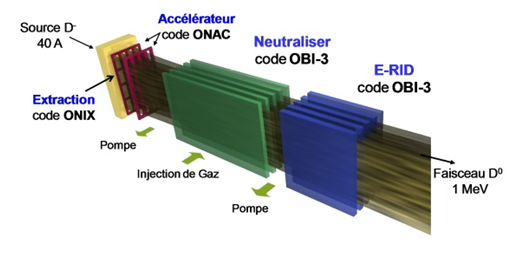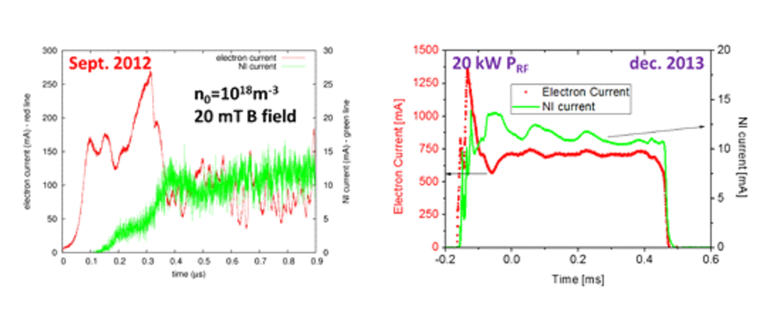Numerical modelling of the formation of a high-energy particle beam (100 keV - 1 MeV) for ITER & CERN
contact : Adrien Revel & Tiberiu Minea
1. Application to the Neutrals Injector (IdN) for ITER
The 'Theory and Modeling of Plasmas - Discharges and Surfaces' (TMP-D&S) team has been working for around ten years on modelling certain sub-assemblies of the ITER project and, more recently, with prospects for the future DEMO fusion device. This involved the development of three models (one protected under licence from the CNRS, Université Paris-Saclay and CEA). All these models are in three dimensions (3D) in space and 3D in velocity space over a distance of around ten meters, all together. They numerically describe the propagation of the energetic particle in the Neutral Beam Injector (NBI) for heating the heavy species of the ITER (International Thermonuclear Experimental Reactor) core plasma. The results provide information on the physico-chemical mechanisms in the NBI, and comparisons with experimental results (Max Planck Institut für Plasmaphysik - IPP, Garching, Germany) have enabled the negative ion extraction model (ONIX) to be validated. This large-scale project involved several members of the team. It was made possible by European support (F4E - Fusion for Energy, EURATOM, EFDA), FR-FCM: French federation for magnetically controlled fusion - CEA /CNRS, and particularly the bilateral collaboration between LPGP(CNRS, France) and IPP (Max Planck, Germany). Other support came from the National Research Agency (ANR ITER-NIS) and the University of Paris-Saclay.
More specifically, the NBI must not only supply part of the energy of the fusion core plasma, particularly to the heavy species (hydrogen and its isotopes), but also transfer current drive, which should make tokamak plasma to operate in advanced confinement modes (H-modes). The overall diagram of the NBI is shown in Figure 1.

Figure 1 – Schematic diagram of the Neutral Beam Injector (NBI) for ITER
Three 3D particle codes (Particle-In-Cell Monte Carlo Collision: PIC-MCC) were produced for three specific regions of the NBI: Extraction, Acceleration, and Neutralizer (Figure 1).
• ONIX (Orsay Negative Ion eXtraction)
This numerical model simulates the extraction of negative ions (NI) from an electronegative plasma (hydrogen or deuterium) through an aperture (typical diameter 14 mm) by high electric fields (~1 kV/mm). ONIX considers both mechanisms of negative ion production - in volume and by electronic attachment to the surface of the plasma grid.
The extraction of NIs from electronegative plasmas is an important issue in plasma physics. In particular, if the current required is high (several amperes), the efficiency of the extraction of NIs becomes crucial, as is the case for the correct operation of the NBI that will have to supply the fusion plasma of ITER with 2x35 MW.
Recent numerical results show very good agreement with experimental measurements, for both the negative ion current extracted from the plasma and the co-extracted electron current. The particle approach used for ONIX has been tested for density plasmas (~1018 m-3) using massively parallel calculations (4096 CPUs - IPP) and validated by comparison with experiments, in particular on the prototype installation (reduced scale 1/8 of ITER) BATMAN of the IPP (Garching, Germany). A bilateral collaboration between LPGP and IPP (Prof. U. Fantz) has started since 2012.
These results clearly indicate the need for a three-dimensional model required by the magnetic filter composed by superimposing two orthogonal magnetic configurations. ONIX can also be used to describe the 3D distribution of the space charge that forms in front of the plasma grid and directly influences the trajectories of the extracted NIs. In addition, it predicts the aberrations of the beam being formed, which propagate and subsequently become accentuated in the accelerator.
As an example, Fig. 2 shows the extracted negative ion currents for the standard case, as a function of the original location of the ions (S. Mochalskyy, D. Wünderlich, U. Fantz, P. Franzen, T. Minea. Comparison of ONIX Simulation Results and Experimental Data from the BATMAN test bed for Study of Negative Ion Extraction, 2016 Nucl. Fusion 56, 106025; doi:10.1088/0029-5515/56/10/106025, M. Lindqvist, D. Wünderlich, A. Mimo, S. Mochalskyy, A. Revel, T. Minea, U. Fantz, Sensitivity of the negative ion beam extraction to initial plasma parameters by 3D particle modeling, Plasma Sources Sci. Technol. 31 (2022) 125001; https://doi.org/10.1088/1361-6595/ac9a6d).
• ONAC (Orsay Negative ion ACcelerator)
This model focuses on the "acceleration" part of the NBI. The negative ions extracted from the source and the co-extracted electrons are subjected to a powerful electric field (1 MV - 50 cm). A magnetic field is added to deflect the undesired co-extracted electrons. ONAC is a 3D PIC-MCC code that models the trajectories of the particles extracted from the source until the end of the accelerator. (A. Revel, S. Mochalskyy, L. Caillault, A. Lifschitz, T. Minea. Transport of realistic beams in ITER neutral beam injector accelerator, 2013 Nucl. Fusion 53, 073027, doi :10.1088/0029-5515/53/7/073027), M. Lindqvist, N. den Harder, A. Revel, S. Mochalskyy, A. Mimo, R. Nocentini, T. Minea, U. Fantz, From meniscus formation to accelerated H- beam: coupling of 3D-PIC and ion-optics simulations, Nucl. Fusion 62 (2022) 126068;https://doi.org/10.1088/1741-4326/ac9c6f).
• OBI (Orsay Beam Injector)
The OBI model studies the neutralisation of negative ions accelerated by collision with a gaseous target. These collisions create a cold but denser plasma than the negative ion beam. This plasma screens the coulombian repulsion beween the beam's particles, greatly reducing its divergence.
2. Application to the Linac4 source of CERN
The ONIX model has been adapted to describe the extraction of negative ions from CERN's very high density plasma source (degree of ionisation > 50%) for injection into the new Linac4 linear accelerator (S. Mochalskyy, J. Lettry, T. Minea, S. Mattei, Ø. Midttun, Study of the different Cs conditioning states of the Linac4 negative hydrogen ion source by 3D PIC-MCC numerical simulations using ONIX code, NIBS 2014 - 4th International Symposium on Negative Ions, Beams and Sources, October 6 -10; Garching, Germany). It should be noted that the ONIX prediction made in 2012, well before construction of the CERN source was completed, was confirmed in November 2013 during the first experimental measurements conducted by Prof. J. Lettry, as shown in Fig. 5. (S. Mochalskyy, J. Lettry, T. Minea, Beam formation in cesiated surfaces and volume accelerator ion-source 2016 New Journal Phys. 18 085011; doi:10.1088/1367-2630/18/8/085011).

Figure 2 - (left) Extracted negative ion current predicted by the OBI3 model. (right) Negative ion current measured at CERN.
